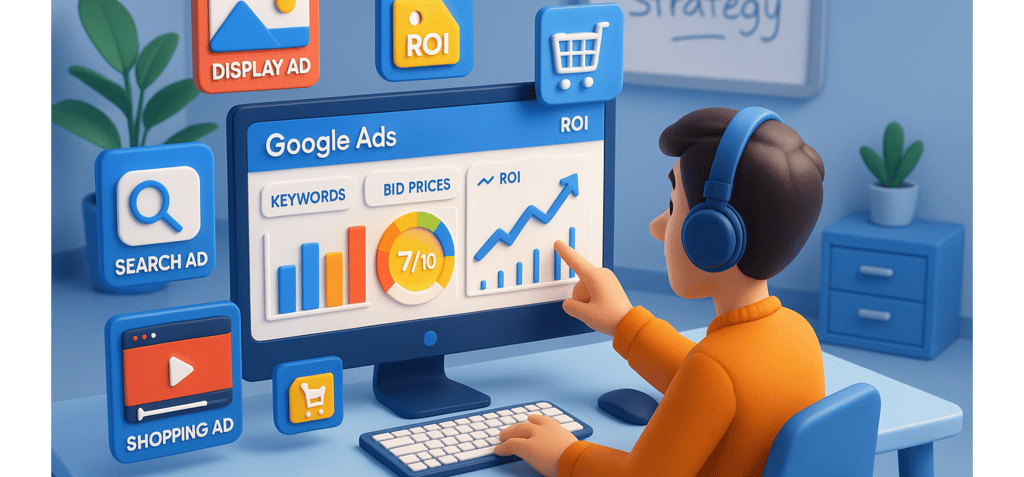How Google Ads Work in Digital Advertising: A Simple Guide
Google Ads is a strong tool in digital advertising. Shopping Ads show product images, prices, and store details in search results. This makes them great for online retailers.It assists companies in reaching their desired audience and boosting sales.
ADS
Sargunjot Singh
7/2/20253 min read


Google Ads is a strong tool in digital advertising. Shopping Ads show product images, prices, and store details in search results. This makes them great for online retailers.It assists companies in reaching their desired audience and boosting sales.
If you own a small business or work in marketing, knowing how Google Ads works can help you make better campaigns. This can increase your ROI (Return on Investment).
In this guide, we will explain how Google Ads works. We will cover its main parts and share tips to improve your campaigns for better results.
1. What Are Google Ads?
Google Ads, previously called Google AdWords, serves as an online advertising platform. Businesses pay to show ads on Google’s search results, websites, YouTube, and other partner sites. It functions on a pay-per-click (PPC) basis, which means advertisers incur costs only when someone clicks their ad.
Why Use Google Ads?
Instant visibility on Google’s top search results
Highly targeted ads based on user intent
Measurable results with detailed analytics
Flexible budgeting (you control spending)
2. How Google Ads Works: The Basics
You will appear in Google Search results when users type in relevant terms. Google Ads works like an auction, where advertisers compete for ad spots. However, it’s not just about the highest bid—Google also considers ad relevance and quality to determine rankings.
Key Steps in Google Ads Process:
Keyword Research – Find the best search terms your audience uses.
Ad Creation – Write compelling ads with strong CTAs (Call-to-Actions).
Bidding Strategy – Set bids for clicks, impressions, or conversions.
Ad Ranking – Google determines ad positions based on Quality Score and bid amount.
Ad Display – Your ads appear on Google Search, Display Network, or YouTube.
Performance Tracking – Monitor clicks, conversions, and adjust campaigns accordingly.
3. Types of Google Ads
Google offers multiple ad formats to suit different marketing goals.
A. Search Ads (Text Ads)
Appear in Google Search results for relevant keywords.
Best for lead generation and direct sales.
When a user searches for “best running shoes,” an ad from a shoe store appears at the top.
B. Display Advertisements (Banner Ads)
Visual ads on websites, blogs, and apps within Google’s Display Network.
Excellent for increasing brand visibility and retargeting efforts.
C. Video Advertisements (YouTube Promotions)
Ads before, during, or after YouTube videos.
Effective for engagement and storytelling.
D. Shopping Advertisements (Product Listings)
Display product visuals, pricing, and retailer names directly within search outcomes.
Perfect for online retail enterprises.
E. Application Promotion Advertisements
Drive app installs and engagement across Google platforms.
4. Google Ads Auction & Quality Score
Google doesn’t just pick the highest bidder—it rewards high-quality, relevant ads.
Factors Affecting Ad Rank:
Bid Amount – How much you’re willing to pay per click.
Quality Score – A rating (1-10) based on:
Ad relevance (Does it match the keyword?)
Click-through rate (CTR) (Do users click it?)
Landing page experience (Is the page useful?)
Ad Extensions – Additional info (phone numbers, links, etc.) that improve visibility.
A higher Quality Score can lower costs and improve rankings!
5. Setting Up a Google Ads Campaign
Here’s a simple step-by-step process:
Step 1: Establish Your Objective
Is it sales, lead generation, increasing website visits, or boosting brand recognition?
Step 2: Select Campaign Format
Options include Search, Display, Video, Shopping, and more.
Step 3: Select Target Audience
Location, age, interests, and device targeting.
Step 4: Conduct Keyword Research
Utilize Google Keyword Planner to identify high-intent search terms.
Concentrate on long-tail keywords (e.g., “top affordable smartphones 2024”).
Step 5: Set Budget & Bidding
Daily budget: How much you’ll spend per day.
Bidding strategy: Manual CPC, Target CPA, or Maximize Clicks.
Step 6: Create Ads
Write clear, engaging ad copy with keywords.
Use ad extensions (site links, call buttons).
Step 7: Launch & Monitor
Track performance in Google Ads dashboard.
Optimize based on CTR, conversions, and cost-per-click (CPC).
6. Optimizing Google Ads for Better Performance
To get the best ROI from Google Ads, follow these optimization tips:
A. Improve Quality Score
Use relevant keywords in ads and landing pages.
Increase CTR with better ad copy.
Ensure fast-loading, mobile-friendly landing pages.
B. Use Negative Keywords
Exclude irrelevant searches (e.g., “free” if you sell premium products).
C. A/B Test Ads
Run multiple versions to see which performs better.
D. Retargeting (Remarketing)
Show ads to users who visited your site but didn’t convert.
E. Track Conversions
Set up Google Analytics to measure sales, sign-ups, etc.
7. Common Google Ads Mistakes to Avoid
Poor keyword selection (too broad or irrelevant).
Ignoring mobile users (optimize for all devices).
Not using ad extensions (missed opportunities for engagement).
Setting and forgetting (continuous optimization is key).
8. Conclusion: Why Google Ads is Essential for Digital Advertising
Google Ads is a powerful PPC advertising tool that helps businesses reach the right audience at the right time. By understanding how Google Ads works, you can choose the right keywords. This will help you improve your campaigns. As a result, you can attract quality traffic, increase sales, and grow your brand.
Final Tips:
Start with a clear goal (sales, leads, or awareness).
Focus on high-intent keywords for better conversions.
Monitor and tweak campaigns regularly.
Use Google Analytics to track performance.
With the right strategy, Google Ads can be a game-changer for your digital marketing success!
